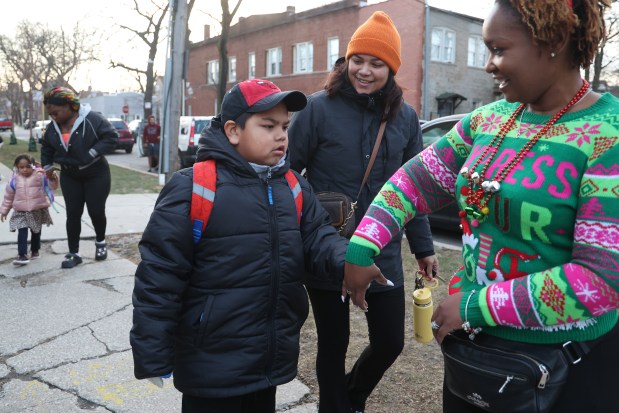Beatrice Garcia credits the special education classroom assistants at Henderson Elementary in Englewood for helping her son speak.
“He hasn’t been verbal,” said Garcia. “But now that he’s been with (the SECAs), he wants to interact with me, he wants to interact with his brother. And he was not showing any of these signs last year at all.”
Having professionals at school she can trust is an immense help to Garcia, a single mother with two sons under the age of 10. Her youngest, JoAngel Tapia, 7, was diagnosed with autism when he was 2.
But Garcia worries special education funding challenges at Chicago Public Schools may jeopardize JoAngel’s ability to have an assistant who can support him.
After hundreds of teacher assistants were laid off at the beginning of last year, CTU ramped up proposals in its ongoing contract talks to consider hiring them to support students with disabilities.
Special education classroom assistants — a different type of CPS aide represented by a different union — expressed concerns about what hiring teacher assisants for their role would do to the quality of care provided to students with complex needs.
In early December, Service Employees International Union Local 73, the union that represents special education classroom assistants, threatened a lawsuit over the dispute, which it said would take work from SEIU members. According to recent data from CPS, there are currently fewer than 1,000 teacher assistants and about 7,000 special education classroom assistants.
While the conflict has big financial implications for total dues payment amounts in both unions, parents, students and special education teacher assistants say they are stuck in the crosshairs.
The two roles are similar but there are differences in the job descriptions.
Special education classroom assistants help students with visual and hearing impairments, learning disabilities and behavior disorders. They provide one-on-one tutoring and personal hygiene and feeding services. They support students who communicate using specialized devices and are trained on how to operate mechanized page-turners.
Teacher assistants, in contrast, monitor hallways and review student identification cards. They help students understand and complete assignments. They provide tutoring under the supervision of the classroom teacher.
“We are not your recess monitors, your lunch attendants. We’re not there to make your photocopies,” said Cara Paliza, a special education assistant at Murphy Elementary School in Irving Park. “We are there for the students. We’re on the ground with them constantly.”
“Having (CTU) try to make us into the same kind of role, even though we have different contract language, will, in this school setting, create some conflict,” she said.
A shortage of aides
Henderson Elementary’s individualized education program for 7-year-old JoAngel has worked, said his mother Garcia. (An IEP outlines the special education services and support a child needs to succeed in school.)
Being able to drop off her son and know he’s in good hands with his special education classroom assistant has, in many ways, saved their family. But with funding for his program running out, she now faces a wall of uncertainty.
She doesn’t know where the district might place JoAngel or how the teacher aides would assist him in a different school. She said thinking of him in a setting without the same one-on-one support makes her heart feel like it’s in her throat.
“I’m not sure what is going to be the next step,” she said. “There’s a shortage of aides … it’s not just my child. It’s the other children in JoAngel’s classroom too.”

An aide who understands a child’s nuances is even more important at a school in a neighborhood such as Englewood, said Jeannine Carrasquillo, a special education teacher assistant at JoAngel’s elementary school. Carasquillo has been a special education aide for two decades.
Before her job at Henderson, Carasquillo worked at Southside Occupational Academy, a transitional center near JoAngel’s school that helps students with disabilities prepare for life beyond school. She’s in touch with several students from that time, who now work jobs in cleaning or security. She said she feels a strong pull to stay in the community.
“I feel like the kids need me … they sometimes get beaten up at home. Whether it’s yelling or more, just how they live is different. Survival. These kids are surviving,” she said.
Carasquillo can sometimes connect with her students or talk them down from a fit of anger or worry even more than their own parents.
It’s because she spends so much time with them, she said. She notices their daily patterns, and every student has specific needs. Some are inseparable from their stuffed animals, others are always thirsty but can’t drink out of a milk carton. Not having certain amenities like a straw or a blanket can throw off a student’s entire day.
Parents learn to lean on her too. They call for advice about medical insurance and how to talk to doctors. The job is a full-time commitment. It can be demanding.
The biggest difference between her job and a TA role, according to Carrasquillo, is her ability to stay with the same group of students for multiple years. TAs in regular academic settings at her school get new kids every year.
“Teacher assistants don’t do half the stuff that we do, and they don’t want to,” Carrasquillo said. “If (CTU members) move forward with their proposal they’re basically going to get a watered-down version of what we do.”
Existing vacancies
CTU, however, argues both the teachers union and SEIU Local 73 members in different paraprofessional position titles have historically performed services for special education students. They say their proposal to consider hiring teacher assistants to support students with disabilities would put pressure on the district to rehire teacher assistants who have been laid off.
Chronic and persistent funding issues for special education within CPS have affected hundreds of families like Garcia’s and exacerbated the conflict between unions, said Daniel Maggin, professor of special education at the University of Illinois Chicago.
“It’s a combination of factors. We are confronting a workforce shortage and we have historically not been able to fund special education adequately,” Maggin said.
In June, CPS laid off over 230 teacher assistants, according to Matthew Luskin, CTU’s chief of staff.
The layoffs are part of a trend, Luskin said. Over the past decade as the district has faced financial pressures, the number of teacher assistants has declined while the number of special education classroom assistants under SEIU Local 73 has gone up. Both positions are some of the lowest-paid in the district, usually with yearly salaries of less than $50,000.
Sandra Lockhart, for example, got an email in May informing her that she would soon have to leave her role as a teacher assistant at LaSalle Elementary in Old Town. She had been at LaSalle for over 20 years.
“It still to this day has not been clarified as to exactly why the position has been eliminated,” Lockhart said.
She said a busload of teacher assistants who had all just been laid off went to Springfield to demand answers.
Lockhart called the community at LaSalle her “work family.” She loved going to different classes and getting to know her wide range of students. She’s attended their graduations and stayed in touch with their families. Some — especially her first students — still stick with her.
“The very first student I ever worked with committed suicide,” Lockhart said, through tears. “But I kept in contact with his mom.”
That boy, named Christian, had a disability, Lockhart said. So did several of her first students.
As special education classroom assistants began to separate themselves from TAs, Lockhart said she works with fewer students who have disabilities. But that doesn’t make her work less important, she said.
“I believe special education classroom assistants are needed in schools. But I also believe that teacher assistants are needed,” she said.
After getting laid off, Lockhart said she didn’t want to work in special education under SEIU Local 73. So, she found a job at Beasley Academic Magnet School in Washington Park as a TA. She said she likes it, but it’s been an adjustment.
Lockhart’s experience speaks for hundreds of people who had been servicing students with disabilities for decades and were let go last year, said Jackson Potter, CTU’s vice president.
“Special education classroom assistants do have a greater level of versatility around hygienic services and other responsibilities. We readily acknowledge that,” said Potter. “They should do that work … but for every other student who doesn’t require those services and there’s a vacancy in the system, we’ve got to fill it.”
In a statement, SEIU Local 73 said it supports the CTU in its attempt to expand teacher assistant positions, but clarified that doesn’t mean it supports TAs performing special education classroom assistant work.
“SEIU 73 is prepared to protect the integrity and dignity of special education classroom assistants’ work and enforce the contractual and legal guardrails put in place to protect and advocate for students with disabilities,” said Stacia Scott, SEIU Local 73 executive vice president.
A commitment
The union’s proposals do clarify that hygiene services require care from specialized education classroom assistants instead of TAs.
But special education assistants do more than hygiene services, said Christine Palmieri, a special education advocate with Matt Cohen and Associates and a former CPS parent who years ago fought for her autistic son to have a dedicated classroom assistant.
“It’s not as straightforward as (CTU) might be thinking it is,” she said. “CPS should restore the cut TA positions as both roles are important and needed — but they are very different. Only SECAs directly support students with disabilities and have the training to do so.”
Special education classroom assistants have protections baked into their current contract with SEIU Local 73 that allow them to spend more minutes with students, according to Palmieri.
SEIU Local 73’s contract also allows the parent of a child with disabilities to request their special education classroom assistant sit in for individualized education program meetings to be part of the planning process.
Tenisha Jackson, a special education assistant who works with severely medically fragile children, said ultimately, many teacher assistants don’t know how to deal with students in crisis situations. Jackson works at Minnie Miñoso Academy in the Bridgeport neighborhood.
“I’ve been in de-escalation classes. I’ve helped kids in the middle of seizures. It’s part of my job because I want it to be,” Jackson said.
Jackson gives her kids space to cry or scream it out, whatever they need in the moment.
Most days, she said, they’re ecstatic to see her.




